Live on the homepage now!
Reader Supported News
Trump’s two Big Lies are getting magnified
America is heading into a presidential election in which Donald Trump is basing his candidacy on two Big Lies — that President Biden stole the 2020 election from him, and that Biden is orchestrating a prosecutorial witch hunt against him.
So you might think the social media companies that in 2020 responded to Trump’s first Big Lie by removing him from their platforms would at least continue their practice. Right?
Wrong.
YouTube has announced that it will no longer remove videos that say the presidential election in 2020 was fraudulent, stolen, or otherwise illegitimate.
The Google-owned video platform nonsensically argues that it had to balance protecting users from lies with protecting “open discussion and debate,” and because it did not wish to “curtail political speech without meaningfully reducing the risk of real-world harm,” it’s now reopened to Trump’s first Big Lie.
Hello?
Facebook’s (Meta’s) policy is even less coherent. In January, it announced that it would reinstate Trump’s Facebook and Instagram accounts, arguing that “the risk to [public safety] has sufficiently receded.”
Really? What planet are you inhabiting, Zuck?
Trump’s team has been posting to Facebook regularly since then, including Big Lie #2 — that his arraignment on possession of classified documents is “a continuation of the greatest witch hunt of all time.”
Don’t even get me started about Elon Musk.
Since taking control of Twitter in October 2022, Musk has had no qualms about posting election-related disinformation, even sharing links containing dubious claims. And restoring the accounts of prominent election deniers.
Despite Musk’s recent assurances that tweets asserting that the 2020 election had been stolen “would be corrected,” the Associated Press noted that “Twitter posts that amplified those false claims have thousands of shares with no visible enforcement.”
Of course there’s no visible enforcement. How can there be any enforcement when Musk has fired almost all the enforcers?
Musk reinstated Trump’s account last November, but Trump has not posted anything so far, probably due to an agreement to post primarily on Truth Social. But that agreement expires this month, and Trump has suggested he may move back to Twitter, which was a crucial part of his 2016 campaign.
Let’s get real. Trump’s Big Lie isn’t over. It’s metastasized into his bid for reelection, along with Big Lie #2. Trump and most Republican lawmakers are using these Big Lies to gain money and votes for 2024.
The direct harms to the public are not receding. They’re compounding.
Worse, Big Lies on social media are magnified through algorithms that give viewers vast multiples of them.
One study found that users who were already skeptical of election results were shown three times as many election denial videos as those who were not.
Not long ago I spoke with a Trump supporter who told me he believed the 2020 election was stolen and that Biden’s “deep state” was persecuting Trump. I asked him why he believed these things. He responded, “Are you kidding? I see and hear it everywhere.”
That’s the problem in a nutshell.
If these giant platforms are intent on allowing Trump’s two Big Lies to warp the minds of even more Americans in the months leading up to the 2024 election, they must be either broken up or regulated. Period.
READ MORE 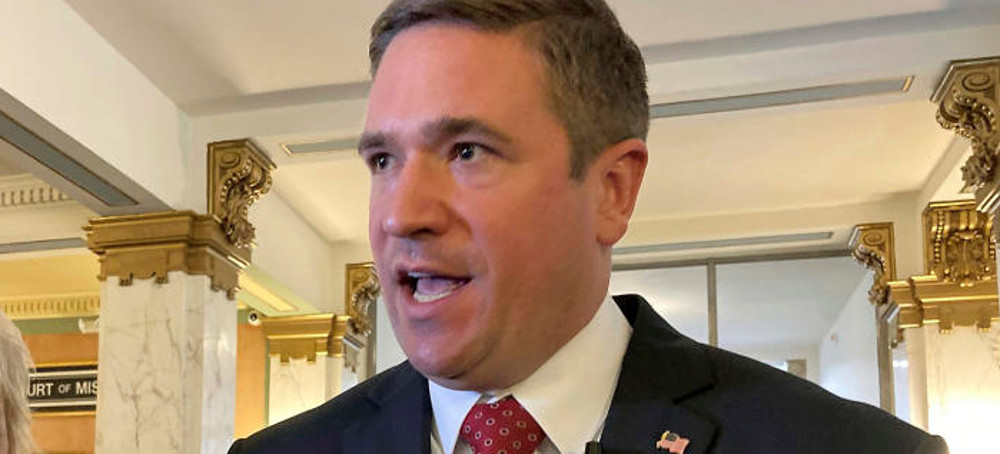 Missouri Attorney General Andrew Bailey speaks to reporters after taking the oath of office in Jefferson City, Mo., Jan. 3, 2023. (photo: David A. Lieb/AP)
Missouri Attorney General Andrew Bailey speaks to reporters after taking the oath of office in Jefferson City, Mo., Jan. 3, 2023. (photo: David A. Lieb/AP)
Cole County Presiding Judge Jon Beetem ordered Attorney General Andrew Bailey to approve fellow Republican Auditor Scott Fitzpatrick's estimated $51,000 price tag on the proposal within 24 hours.
Bailey had refused to approve the price estimate, arguing that if the proposal were to succeed, it could cost the state as much as a million times more than that figure because of lost Medicaid funding or lost revenue that wouldn’t be collected from people who otherwise would be born.
But Beetem said Bailey has “no authority to substitute his own judgment for that of the Auditor.”
“There is an absolute absence of authority to conclude the Attorney General is permitted to send the Auditor’s fiscal note summary back to revision simply because he disagrees with the Auditor’s estimated cost or savings of a proposed measure,” Beetem wrote in his ruling.
A spokesperson said the attorney general's office will appeal.
If approved by voters, the proposal would enshrine in the constitution the individual right to make decisions about abortion, childbirth and birth control.
Missouri's Republican-led Legislature and Republican governor banned nearly all abortions after the U.S. Supreme Court overturned Roe v. Wade last summer. The state now allows exceptions for medical emergencies, but not for cases of rape or incest.
In Missouri, the auditor is required to calculate how much taxpayer money it could cost to implement ballot measures. The attorney general then reviews and approves the cost estimate in an administrative step that historically has been uneventful.
Fitzpatrick’s office in March found that the proposal would have no known impact on state funds and an estimated cost of at least $51,000 annually in reduced local tax revenues, although “opponents estimate a potentially significant loss to state revenue.”
Bailey said that cost estimate was so low it would bias voters and told Fitzpatrick to change it.
Fitzpatrick refused, arguing that a multibillion-dollar projection for the initiative petition would be inaccurate, despite Fitzpatrick’s personal opposition to abortion.
“As much as I would prefer to be able to say this IP would result in a loss to the state of Missouri of $12.5 billion in federal funds, it wouldn’t,” Fitzpatrick wrote in an April 21 letter to Bailey. “To submit a fiscal note summary that I know contains inaccurate information would violate my duty as State Auditor to produce an accurate fiscal note summary.”
The standoff had blocked the secretary of state from allowing the pro-abortion rights campaign to start collecting signatures from voters. The campaign would need to collect signatures from 8% of legal voters in six of the state’s eight congressional districts in order to get the proposal on the 2024 ballot.
In his ruling, Beetem wrote that Bailey's refusal to approve the cost estimate meant that the abortion rights campaign lost out on 50 days of gathering voter signatures.
“His illegal actions have obstructed the statutorily prescribed timeline twice over, showing a depth of antipathy towards our right to direct democracy in an attempt to prevent Missourians from voting for their reproductive freedom," said Tony Rothert, director of integrated advocacy at the ACLU of Missouri. which represented a plaintiff from the campaign.
READ MORE 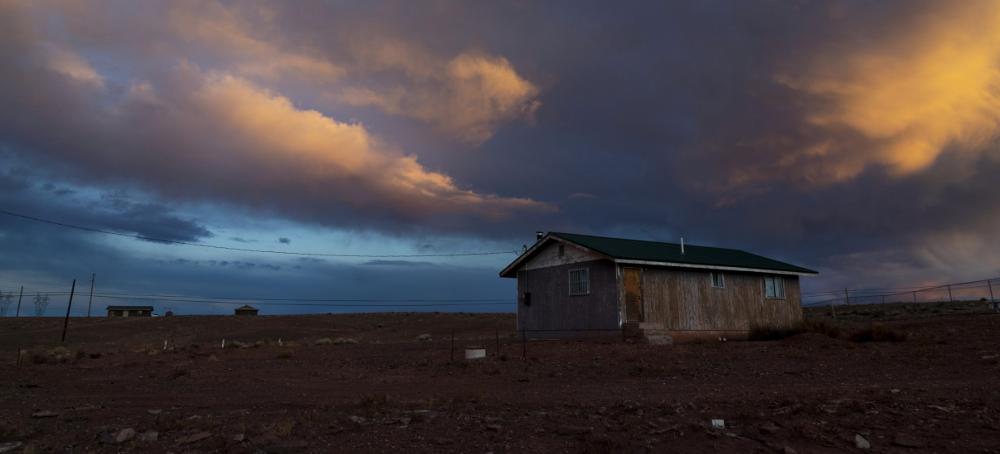 Native American tribe argued federal government had not fulfilled obligations in battle over dwindling water supplies. (photo: Reuters)
Native American tribe argued federal government had not fulfilled obligations in battle over dwindling water supplies. (photo: Reuters)
Native American tribe argued federal government had not fulfilled obligations in battle over dwindling water supplies
Some of the main states that draw water from the river – Arizona, Nevada and Colorado – and water districts in California that are also involved in the case, had urged the court to decide for them, which the justices did in a 5-4 ruling.
Colorado had argued that siding with the Navajo nation would undermine existing agreements over the share of dwindling water supplies and disrupt the management of the river.
The Biden administration had said that if the court were to come down in favor of the Navajo nation, the federal government could face lawsuits from many other tribes.
Lawyers for the Navajo nation, located in the south-west with a resident population of about 175,000 and the largest area of US land held by a Native American tribe, had characterized the tribe’s request as modest, saying they simply were seeking an assessment of the tribe’s water needs and a plan to meet them.
The facts of the case go back to treaties that the tribe and the federal government signed in 1849 and 1868. The second treaty established the reservation as the tribe’s “permanent home” – a promise the Navajo nation says includes a sufficient supply of water. In 2003 the tribe sued the federal government, arguing it had failed to consider or protect the Navajo nation’s water rights to the lower portion of the Colorado River.
A federal trial court initially dismissed the lawsuit, then an appeals court allowed it to go forward.
During arguments in the case in March this year, Justice Samuel Alito, on the bench’s right wing and currently embroiled in a scandal over gifts and his pushback via the media, pointed out that the Navajo nation’s original reservation was hundreds of miles away from the section of the Colorado River it now seeks water from.
Today, the Colorado River flows along what is now the north-western border of the tribe’s reservation, which extends into New Mexico, Utah and Arizona. Two of the river’s tributaries, the San Juan River and the Little Colorado River, also pass alongside and through the reservation. Still, one-third of the approximately 175,000 people who live on the reservation do not have running water in their homes.
The government said it has helped the tribe secure water from the Colorado River’s tributaries and provided money for infrastructure, including pipelines, pumping plants and water treatment facilities. But it said no law or treaty required the government to deal with general water needs.
The states argued that the Navajo nation was attempting to make an end run around a supreme court decree that divvied up water in the river’s lower basin.
It was a 5-4 ruling, written by Justice Brett Kavanaugh.
Justice Neil Gorsuch, typically an ultra-conservative but also a strong champion of Native American rights and tribal sovereignty, dissented alongside liberal-leaning Sonia Sotomayor, Elena Kagan and Ketanji Brown Jackson.
He wrote, in part: “In the Navajos’ view, the federal government’s efforts to assist the Navajos with their water needs did not fully satisfy the trust obligations of the United States under the 1868 treaty.
“The Navajos filed suit seeking to compel the United States to take affirmative steps to secure needed water for the tribe – including by assessing the tribe’s water needs, developing a plan to secure the needed water, and potentially building pipelines, pumps, wells, or other water infrastructure.
“The states of Arizona, Nevada, and Colorado intervened against the tribe to protect those states’ interests in water from the Colorado River.”
READ MORE 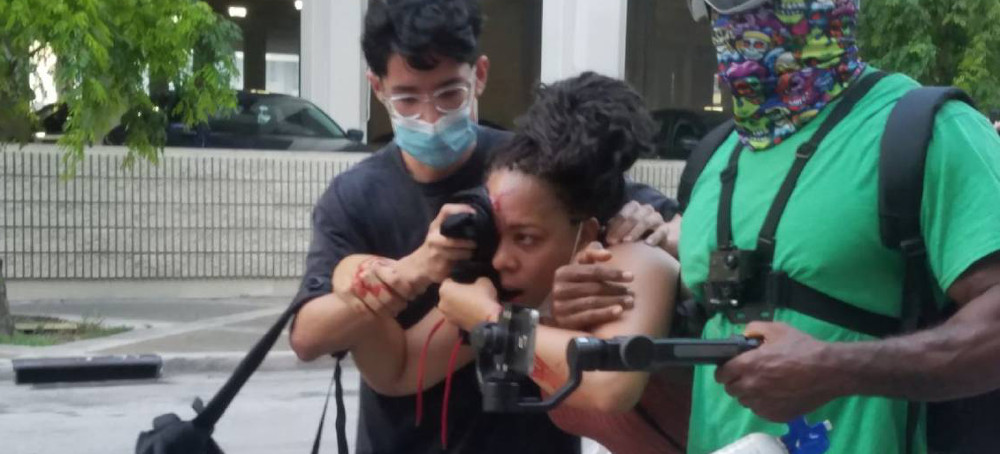 After a police officer shot LaToya Ratlieff in the face with a hard-packed foam rubber bullet as she stumbled away from tear gas, other protesters rushed to the aid of the bleeding woman. (photo: AP)
After a police officer shot LaToya Ratlieff in the face with a hard-packed foam rubber bullet as she stumbled away from tear gas, other protesters rushed to the aid of the bleeding woman. (photo: AP)
George Floyd Protester Shot in Face With Rubber Bullet Scores a Victory in Legal Fight With Fort Lauderdale
Camellia Burris, The Miami Herald
Burris writes: "Over three years after Fort Lauderdale police officer Eliezer Ramos shot a foam rubber bullet into the face of LaToya Ratlieff, a federal judge ruled that the officer’s defense of 'just-following-orders' does not afford him qualified immunity from Ratlieff’s civil rights lawsuit against him."
Over three years after Fort Lauderdale police officer Eliezer Ramos shot a foam rubber bullet into the face of LaToya Ratlieff, a federal judge ruled that the officer’s defense of “just-following-orders” does not afford him qualified immunity from Ratlieff’s civil rights lawsuit against him.
The recent ruling means that Ramos may not enjoy the protection from personal liability that is usually afforded public officials facing civil lawsuits.
In the wake of the killing of George Floyd in Minneapolis and the marches across the country that soon followed, some of which spawned violence, Ratlieff took to the streets of Fort Lauderdale to peacefully protest on May 31, 2020. As she was leaving the rally, Ramos shot a rubber bullet into the crowd, striking Ratlieff just above her right eye.
In May 2022, Ratlieff filed a federal civil rights lawsuit against the city of Fort Lauderdale, the Fort Lauderdale Police Department, Ramos and several other officers. The 36-page complaint alleges that the hard projectile caused “serious and permanent eye damage, neurological injuries, and other directly attributable physical and emotional injuries.”
Ratlieff is alleging violations of the First, Fourth and 14th amendments. She also accuses officers of battery for both the use of impact projectiles and tear gas as well as negligence in the use of impact weapons.
Ratlieff alleges that Ramos fired the direct impact round “in aid of dispersing the crowd of demonstrators,” “to stop a peaceful demonstration,” and “to ensure that crowds of peaceful demonstrators could no longer peacefully practice their First Amendment-protected rights.”
U.S. District Judge Rodolfo Ruiz denied Ramos’ motion to dismiss many of the claims against him, including counts of free speech violation, battery, and negligence.
In his motion to dismiss Ratlieff’s complaint, Ramos argued that he is entitled to qualified immunity from her claim that he violated her First Amendment rights.
Qualified immunity is a legal defense to shield public officials, like law enforcement officers, from liability in private civil actions so long as they did not violate a clearly established constitutional right.
Ramos argued that he is entitled to qualified immunity because it is not clearly established “that following a directive to utilize less-than-lethal force during a protest where rioters w[ere] ‘throwing bottles, rocks, and other non-deadly objects’” violates a plaintiff’s First Amendment rights “in . . . bright line terms.”
Similarly, his fellow officers, Douglas MacDoughall, Robert Dietrich, Paul Cristafaro, Avery Figueras, and Steven Greenlaw, also named as defendants in the amended complaint, argued that it is not clearly established that issuing the aforementioned directive violates the First Amendment.
Ruiz rejected these arguments, finding that directing “subordinate officers to use less-than-lethal weapons to disperse a crowd at a large public demonstration” violates a demonstrator’s First Amendment rights because of the “broader, clearly established principle that peaceful demonstrators have a First Amendment right to engage in expressive activities.”
Ruiz further found Ramos’ distinction that he was following a directive rather than issuing a directive inconsequential because he had sufficient reason to “question the validity of” that order.
Ratlieff’s attorneys, Michael Davis, Stuart Ratzan and Ben Kuehne, provided the following statement: “We are grateful that Judge Ruiz recognized that Detective Ramos’ actions do not meet the standard for qualified immunity. We look forward to taking LaToya’s case to a jury early next year.”
Ruiz’s decision to deny the officers’ request for qualified immunity is not shocking due to the stage of the legal proceedings, according to Joanna Schwartz, a law professor at UCLA and author of the book “Shielded: How the Police Became Untouchable.”
“Relatively few qualified immunity motions are granted during the motion- to-dismiss stage because you need to take the facts as the plaintiff has alleged them in their complaint,” Schwartz said in an interview with the Herald.
Since the lawsuit is still in the discovery process — the formal process of exchanging information between the parties about the witnesses and evidence — the officers may again raise the issue of qualified immunity after discovery is complete during a motion for summary judgment. They can also raise it on what is called an interlocutory appeal, in which the Court of Appeals would assess the issue.
Judge Ruiz did, however, grant the defendants’ requests to dismiss counts for violations of Ratlieff’s Fourth Amendment rights and due process. Specifically, the court found that there was no violation of the Fourth Amendment — which protects people from unreasonable searches and seizures — because the situation did not constitute a “seizure.” Ruiz also dismissed a claim for free speech violations on the part of the city.
The order allows Ratlieff to file a second amended complaint revising her claims.
The Fort Lauderdale Police Department declined to comment on pending litigation.
Ratlieff marched with other protesters to the police headquarters in Fort Lauderdale in the aftermath of George Floyd’s death at the hands of Minneapolis police officers. With trained volunteer marshals present to de-escalate tensions, the rally went on without incident. Organizers closed the event and the crowd dispersed, breaking off into small groups as they headed toward cars parked nearby.
Trouble began when a group of protesters spotted officers lined up in a nearby parking garage and stopped to hold up signs and chant. An officer with a history of use-of-force incidents, Steven Pohorence, walked into the crowd and shoved a kneeling woman in the head, video of the incident shows.
Protesters began throwing water bottles in retaliation.
Police cloaked in riot gear responded with rubber bullets and tear gas.
Pohorence was charged with misdemeanor battery. He was found not guilty by a jury in December 2022.
Body camera footage showed officers shooting at protesters, while exchanging wisecracks with one another.
According to Ratlieff’s lawsuit, the officers gave no dispersal warning, a requirement before deploying “less lethal” munitions and chemical agents for crowd control. While walking back to her car, Ratlieff saw the group of agitated protesters and said she tried to de-escalate the situation in moments between the spraying of rubber bullets and tear gas. Video shows her kneeling on the ground, encouraging other protesters to join her to show the officers that they were peaceful. She held a sign that read: “Stop killing us.”
Ratlieff alleged in her complaint that the police “unlawfully” used impact munitions and chemical agents as part of an effort to impede constitutionally protected rights and that this was done “maliciously and sadistically done to harm and injure those gathered, including the plaintiff.” Ratlieff was coughing, choking on tear gas, and stumbling away when Ramos shot a two-inch, hard projectile from a distance of approximately 30 feet. It struck her in the forehead, fracturing her right eye. She collapsed in a puddle of blood.
The Fort Lauderdale Police Department’s training protocols state officers should only aim for the head and neck if deadly force is warranted. Ramos later told investigators that he was aiming for a man behind Ratlieff who tossed a tear gas canister back at police. Ramos was cleared in an internal investigation into whether there had been misconduct. The city’s police chief, Rick Maglione, resigned amid the controversy.
Qualified immunity is a hotly contested issue. Proponents argue that it is necessary to shield public officials from liability, distraction, and harassment when they are performing their duties. Opponents insist that the doctrine is a barrier to justice for victims of police misconduct.
The death of Floyd, 46, who cried out “I can’t breathe” as his face was pressed to the pavement under the knee of an officer for nine minutes and 29 seconds, resulted in the conviction of former police officer Derek Chauvin for second-degree murder.
It has spawned proposed legislation, called the George Floyd Justice Policing Act, that would limit qualified immunity in addition to other reforms. Efforts to pass the legislation have been unsuccessful, with qualified immunity being a major sticking point.
READ MORE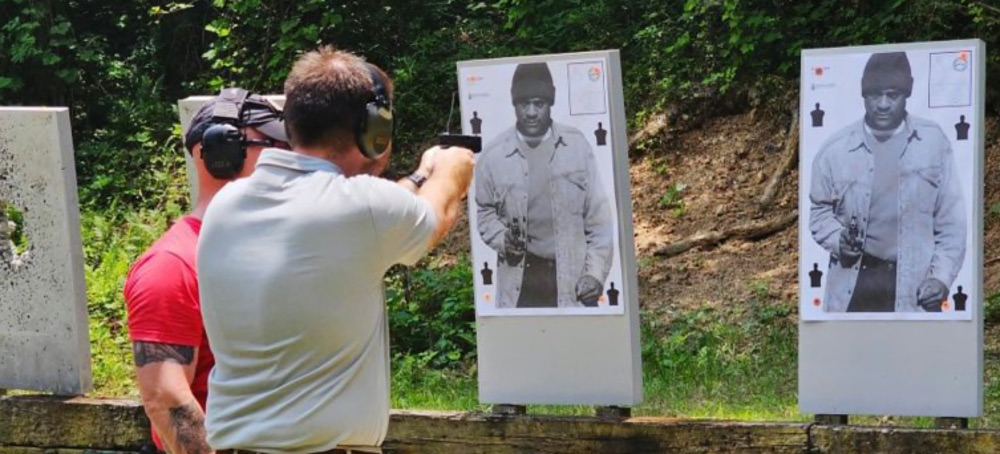 The Villa Rica Police Department in Georgia is facing intense backlash after it hosted a handgun class over the weekend with a target that depicts a Black man in a beanie pointing a gun. (photo: Villa Rica Police Dept.)
The Villa Rica Police Department in Georgia is facing intense backlash after it hosted a handgun class over the weekend with a target that depicts a Black man in a beanie pointing a gun. (photo: Villa Rica Police Dept.)
Villa Rica police posted the photos on their Facebook page, showing participants using an image of a Black man as a target during a firearms safety class.
The police department in Villa Rica, about 33 miles west of Atlanta, held the event on Saturday and posted on its Facebook page photos of participants aiming their guns at targets that featured a life-sized photo of a Black man. The man on the targets is pointing a gun and wearing a beanie.
The photos have since been taken down from the Facebook page but screenshots have been widely shared and criticized on social media.
The Villa Rica Police Department responded to the backlash in a Facebook post on Wednesday, stating, “It was never our intention to be insensitive, inflammatory or offensive to anyone.” The department also said it respects the “honest opinions of our fellow citizens” and apologized for “any offense we may have caused.”
Villa Rica’s chief of police, Michael Mansour, said the targets with Black men are used all over the state for training and that during the class the department also used other targets depicting individuals who were white and Asian. The officer who posted the photos, who Mansour declined to identify, mistakenly posted photos of only the Black targets that were used.
“It’s just an innocent mistake, but it was a mistake,” Mansour told NBC News. “And I’m very transparent in saying that we messed up. But at no time will I accept people telling me I’m a racist, or our department is a racist because we made a mistake.”
NBC News has reviewed photos of targets with images of white people that Mansour says were used during the class.
Villa Rica Mayor Gil McDougal told The Telegraph on Wednesday that he was “personally embarrassed” by the photos and said that the “incident does not reflect the values of this community.” McDougal has launched an investigation into the department.
The NAACP of Carroll County, where Villa Rica is located, issued an open letter to the department’s chief officer on Wednesday, calling the target “extremely offensive.” The group also requested a meeting with city leaders to discuss the incident.
“These types of targets have been used by other police departments within the U.S. and have been deemed racially inappropriate and unacceptable,” wrote NAACP Carroll County president Dominique Conteh. Mansour said he plans to meet with Conteh and McDougal next week to discuss the incident.
This is not the first time police departments have faced backlash over using targets with Black people. A Michigan police department conducted a legal review last year after photos surfaced showing photos of Black men being used as targets.
READ MORE 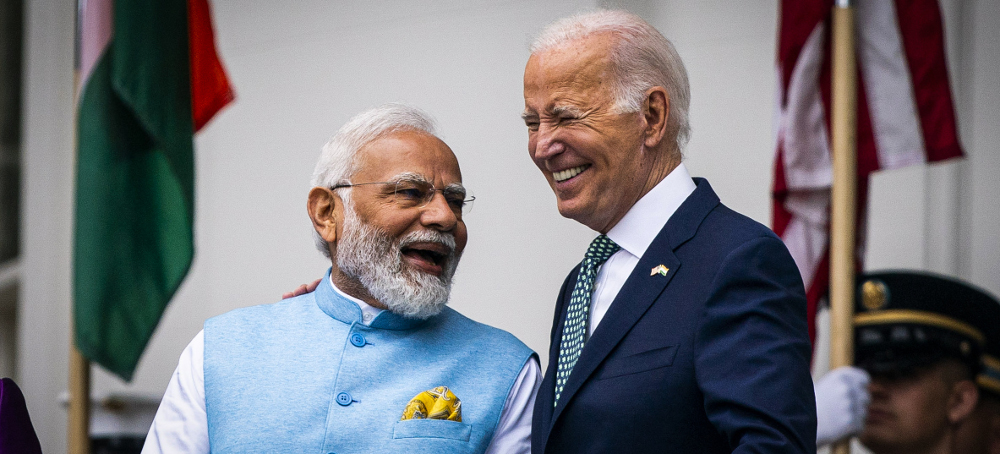 President Joe Biden, right, and Narendra Modi, India's prime minister, at an arrival ceremony at the White House in Washington, D.C., June 22, 2023. (photo: Al Drago/Bloomberg)
President Joe Biden, right, and Narendra Modi, India's prime minister, at an arrival ceremony at the White House in Washington, D.C., June 22, 2023. (photo: Al Drago/Bloomberg)
The Biden administration has ignored India’s rights violations in favor of weapons sales and geopolitical expediency.
Yet while Modi’s visit has been touted as the blossoming of a friendship between two of the world’s largest democracies, the rosy optics have clouded out a darker story: the increasingly grim fate of Indian political prisoners, including many well known to Western nongovernmental organizations and media establishments, under the right-wing Modi government.
A long list of Indian civil society members are currently languishing in the country’s prisons.
Perhaps the most emblematic example is Khurram Parvez, a Kashmiri human rights activist and chair of the Asian Federation Against Involuntary Disappearances. Parvez, 45, has for years been at the forefront of documenting human rights violations in Kashmir, particularly torture, extrajudicial detention, and mass killings, during a long-running insurgency in the territory. He was arrested in November 2021 amid a broader Indian government crackdown and has been in prison ever since. His arrest has not gone entirely unnoticed: Time magazine in 2022 named Parvez on their list of the 100 most influential people in the world, calling him a “modern-day David who gave a voice to families that lost their children to enforced disappearances, allegedly by the Indian state.”
Despite his prominent status, the fate of Parvez and others like him, has not figured much into the celebratory pronouncements about the U.S.-India relationship. Although the United Nations Working Group on Arbitrary Detention recently criticized his detention and called for his release, no major U.S. human rights organization has issued a statement about Parvez timed to Modi’s high-profile U.S. visit. That silence has had a chilling effect with repercussions far beyond his own fate.
“Over the past 20 years, Khurram has become the face of human rights work in Kashmir, as well as the person who was the most vocal and outgoing in making connections with the international community. He was someone that others assumed had implicit protections because of his notoriety,” said Imraan Mir, co-founder of the Kashmir Law and Justice Project. “His arrest has effectively meant the end of any human rights work in Kashmir. Famous people all over the world know Khurram and call him their friend. If we can’t even get them to speak up about his case, who is going to speak about a 16-year-old with no connections in prison?”
Parvez is only one of many prominent Indian activists and journalists who have disappeared into prison over the past several years under Modi’s government. A few of the other most famous names include Fahad Shah, a contributing writer for American left-wing magazine The Nation; Irfan Mehraj, a writer for Deutsche Welle and Al Jazeera; activists Sharjeel Imam and Umar Khalid; and countless others who have had the misfortune of running afoul of Modi’s ruling Bharatiya Janata Party.
India’s prisons have begun to fill with many of its own highly educated citizens, even as the BJP continues to grow in popularity, in part through flashy economic and infrastructure projects planned for completion across the country.
Modi is widely expected to win in elections scheduled for next year. The Indian leader, whose star has risen in the U.S. years after he was banned from the country for his alleged involvement in serious human rights abuses, is also set to give a speech to a joint session of Congress on Thursday.
A perception of democratic backsliding in India under his rule has led several progressive U.S. politicians to announce a boycott of the address, including members of the so-called Squad: Reps. Alexandria Ocasio-Cortez, D-N.Y.; Rashida Tlaib, D-Mich.; and Ilhan Omar, D-Minn.
“A joint address is among the most prestigious invitations and honors the United States Congress can extend. We should not do so for individuals with deeply troubling human rights records — particularly for individuals whom our own State Department has concluded are engaged in systematic human rights abuses of religious minorities and caste-oppressed communities,” Ocasio-Cortez said in a statement, calling on colleagues who support “pluralism, tolerance and freedom of speech” to join her in sitting out the address.
Despite the symbolic value of the boycott, these members of Congress are clear outliers in the U.S. establishment, which has shown minimal reservations about embracing Modi.
The strategic reasons for doing so — including tapping into what is believed to be a major market in the future for Western companies and shoring up military cooperation to contain China in case of a conflict — seem compelling on the surface. Letting human rights fall entirely by the wayside, however, risks making a mockery of the oft-repeated claim that India and the U.S. are bound by values as opposed to merely interests.
“Anyone who criticizes the government, whether human rights defenders, journalists, or climate change activists, is being harassed or, in the worst case, detained and charged under the country’s sedition laws,” said Juliette Rousselot, program officer for West and South Asia for the International Federation for Human Rights. “Khurram’s case is emblematic of Indian authorities’ systematic muzzling of civic space in India. Kashmiris bear the brunt of that policy, but he’s far from the only victim. His case has unfortunately not gotten as much attention as we would like for a number of reasons. But, generally speaking, it is because Western countries have been very reluctant to criticize India on its human rights record.”
Despite calls to prioritize human rights matters in the context of the U.S.-India bilateral relationship, there is little indication that the fate of political prisoners in India has figured into discussions between the two leaders at all, which have seemed more prominently focused on securing lucrative weapons deals for the future. In that context, human rights — and the fate of activists like Parvez, among others — has come to be seen by many as merely a distraction from more important matters.
“People in policy circles have a notion that if they speak about human rights issues, Indians will get very angry,” said Mir, the Kashmiri legal advocate. “So they don’t want to ruffle any feathers.”
READ MORE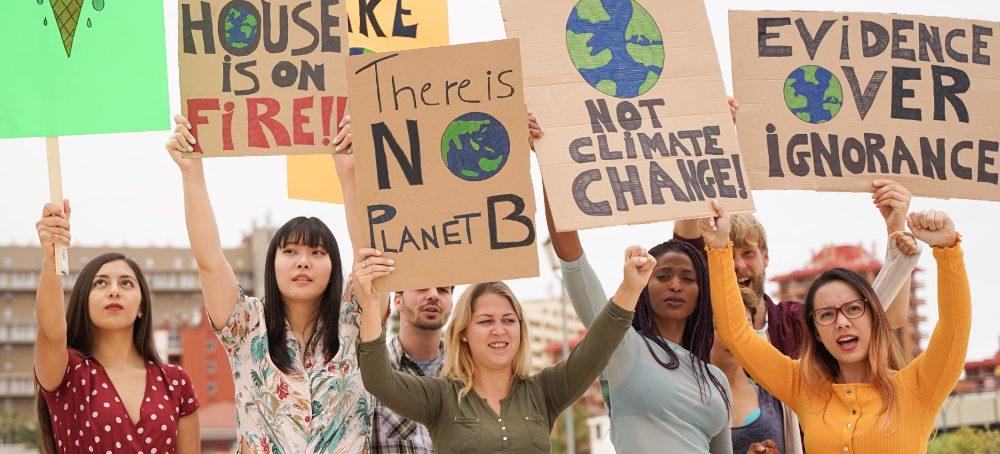 In reality, about two-thirds of Americans support transformative climate policies, like a carbon tax or Green New Deal. (photo: Reuters)
In reality, about two-thirds of Americans support transformative climate policies, like a carbon tax or Green New Deal. (photo: Reuters)
In reality, about two-thirds of Americans support transformative climate policies, like a carbon tax or Green New Deal.
“What we found is that the vast majority of Americans underestimate just how many of their fellow Americans support these transformative climate policies, like a carbon tax or a Green New Deal, or a 100% renewable energy mandate,” says Gregg Sparkman, an assistant professor in the department of psychology and neuroscience at Boston College.
His team asked more than 6,000 Americans to estimate the percentage of other Americans who worry about climate change and support climate policies. They compared those numbers with polling data from Yale and George Mason University.* “While actual supporters of climate policies outnumber opponents two to one, we see that Americans think it’s the other way around,” Sparkman says.
This misperception matters. When people feel alone in their views, they are less likely to take action. So he says it’s important to start conversations about climate change — “to voice your concerns about climate change to others, to talk about climate policies that you think are exciting: These kinds of conversations, when done en masse, will help correct this misperception,” Sparkman says.
Follow us on facebook and twitter!
PO Box 2043 / Citrus Heights, CA 95611



No comments:
Post a Comment
Note: Only a member of this blog may post a comment.